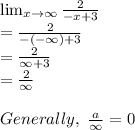Answer:
The limit leads to a determinate form.

Explanation:
The following are indeterminate forms.

Given the limit of a function
 , to show if the given limit is determinate or indeterminate form, we will need to substitute the value of -
, to show if the given limit is determinate or indeterminate form, we will need to substitute the value of -
 into the function as shown,
into the function as shown,

where a is any constant, therefore

Since we are able to get a finite value i.e 0, this shows that the limit does exist and leads to a determinate form